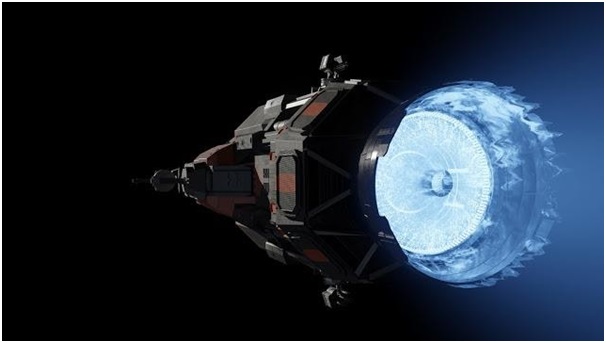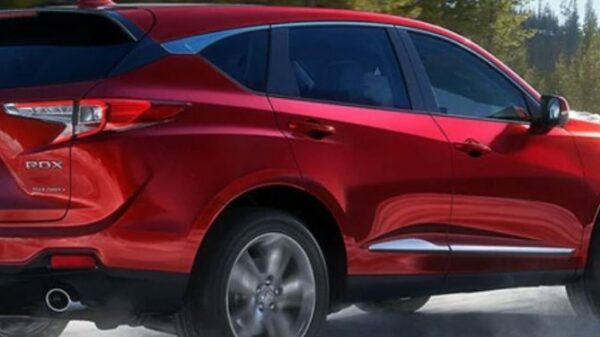We aim to take a fictional propulsion technology from The Expanse, and apply the appropriate science to explain its features in a realistic manner.

This also applies to other SciFi settings that want a similar engine for their own spacecraft.
The Epstein Drive

Title art is from here.
Central to the setting of The Expanse is a very powerful fusion-powered engine that allows spacecraft to rocket from one end of the Solar System to the other quickly and cheaply.
It reduces interplanetary trips to days or weeks, allows small shuttles to land and take off from large planets multiple times and accelerate at multiple g’s for extended amounts of time.
Such a propulsion system is known as a ‘torch drive’: huge thrust, incredible exhaust velocity and immense power inside a small package.
Fusion energy can certainly provide these capabilities. Using fuels like Deuterium provides over 90 TeraJoules of energy per kilogram consumed. Proton fusion, the sort which powers our Sun, could release 644 TJ/kg if we could ever get it to work.

The Epstein Drive (art Gautam Singh) is described in The Expanse as a breakthrough in fusion propulsion technology. A short story provides some details. A small spaceship equipped with this engine could reach 5% of the speed of light in 37 hours, averaging over 11g’s of acceleration. A magnetic bottle is mentioned. Since we don’t know the mass of the vehicle or what percentage of it was propellant, we can’t work many useful details.
The main book series and the TV show focus on the adventures of the Rocinante and its crew. We know that it uses laser-ignited fusion reactions and water as propellant. Again, we don’t have a mass or propellant fraction, so we cannot get definitive performance figures. However, we have detailed images of its interior and exterior. Note that there are no radiator fins or any heat management system visible.

The cross-section also reveals that there is very little room for propellant. Despite this, it can accelerate at over 12g’s and has reached velocities of 1800km/s while averaging 5g. Presuming that it can slow down again and jet off to another destination, this implies a total deltaV on the order of 4000km/s, which is 1.33% of the speed of light.
Official figures for the masses of spacecraft from The Expanse do exist. In collaboration with the TV show’s production team, SpaceDock created a series of videos featuring ships such as the Donnager-class Battleship for which a mass of 250,000 tons is provided.

Using the battleship’s dimensions, we obtain an average density of about 20 to 40 kg/m^3. For comparison, the ISS has a density of 458 kg/m^3. We will use this average density for now, but you can read the Scaling section below to understand how different mass assumptions for the Rocinante don’t ‘break’ our workings so far.
Applying the battleship density to the Rocinante’s size gives us a mass of about 130 to 260 tons. It is likely to change a lot depending on what the ship is loaded with, seeing as it is almost entirely made up of empty volumes. We’ll use a 250 tons figure for an empty Rocinante and add propellant to it as needed.
Let’s put all these numbers together.

The Epstein drive technology allows for >250 ton spacecraft to accelerate for several hours at 5g with bursts of up to 12g, achieving a deltaV of 4000km/s, while not having any radiators and a tiny propellant fraction.
Can we design a realistic engine that can meet these requirements?
The Heat Problem

The biggest problem we face is heat.
No engine is perfectly efficient. They generate waste heat. Some sources of waste heat are physically unavoidable, however performant the machinery becomes.
Fusion reactions result in three types of energy: charged kinetic, neutron kinetic and electromagnetic.

Charged kinetic energy is the energy of the charged particles released from a fusion reaction. For a proton-Boron reaction, it is the energy of the charged Helium ions (alpha particles) that come zipping out at 4.5% of the speed of light.
We want as much of the fusion reaction to end up in this form. Charged particles can be redirected out of a nozzle with magnetic fields, which produces thrust, or slowed down in a magnetohydrodynamic generator to produce electricity. With superconducting magnets, the process of handling and using charged kinetic energy can be made extremely efficient and generate practically no heat.
Neutron kinetic energy is undesirable. It comes in the form of neutrons. For deuterium-tritium fusion, this represents 80% of the fusion output. We cannot handle these particles remotely as they have no charge, so we must use physical means. Neutron shields are the solution; the downside is that by absorbing neutrons they convert their all of their energy into heat. This is a problem because materials have maximum temperatures and we cannot really use radiator fins to remove the heat being absorbed.

Electromagnetic radiation is another unavoidable source of heat. Mirrors can reflect a lot of infrared, visual and even ultraviolet wavelengths. However, fusion reactions happen at such a high temperature that the majority of the electromagnetic radiation is in the form of X-rays. These very short wavelengths cannot be reflected by any material, and so they must also be absorbed.
With this information, we can add the following requirements:
-We must maximize energy being released as charged particles.
-We must minimize heat from neutron kinetic and electromagnetic energy.
Thankfully, there is a fusion reaction that meets these requirements.

Diagram from here.
Helium-3 and Deuterium react to form charged Helium-4 and proton particles. Some neutrons are released by Deuterium-Deuterium side reactions, but by optimizing the reaction temperature, this can be reduced to 4% of the total output. An excess of Helium-3 compared to Deuterium helps reduce the portion of energy wasted as neutrons down to 1%. Another 16% of the fusion energy becomes X-rays. Other ‘cleaner’ source of fusion energy exists, using fuels such as Boron, but they cannot be ignited using a laser.
An optimized Deuterium and Helium-3 reaction therefore releases 1 Watt of undesirable energy (which becomes waste heat if absorbed) for every 4 Watts of useful energy.
If this reaction takes place inside a spaceship, then all of the undesirable energy must be turned into heat. However, if it is done outside the spaceship, then we can get away with only absorbing a fraction of them. It’s the idea behind nuclear pulsed propulsion.
How else do we reduce the potential heat a spaceship has to absorb?
Distance.
A fusion reaction produces a sphere of very hot plasma emitting neutrons and X-rays in all directions. A spaceship sitting near the reaction would eclipse most of these directions and end up absorbing up to half of all this undesirable output.
If the fusion reaction takes place further away, less of the undesirable output reaches the spaceship and more of it escapes into space.
It is therefore a good design choice to place the fusion reaction as far away as possible. However, we are limited by magnetic field strength.

The useful portion of the fusion output, which is the kinetic energy of the charged particles, is handled by magnetic fields to turn it into thrust. Magnetic fields quickly lose strength with distance. In fact, any magnetic field is 8 times weaker if distance is merely doubled. 10 times further away means a field a 1000 times weaker. If we place the fusion reaction too far away from the source of these magnetic fields, then the useful fusion products cannot be converted into thrust.
We could calculate exactly how far the fusion reaction could take place from the spaceship while still being handled by magnetic fields, but whether you use magnetic beta (magnetic pressure vs plasma pressure) or the ion gyroradius (turning radius for fusion products inside a magnetic field), it is clear that kilometres are possible with less than 1 Tesla. For a setting with the Expanse’s implied technology level, generating such field strengths is easy.
What does this all mean for a fusion engine?

If we can generate a magnetic field strong enough to deflect fusion particles at a considerable distance, then we can convert a large fraction of the fusion output into thrust while only a small fraction of harmful energies reaches the spaceship.
The Rocinante is about 12 meters wide. If we describe it as a square, it has a cross-section of about 144m^2. A fusion reaction taking place 20 meters away from the spaceship would have spread its undesirable energies (neutrons and X-rays) over a spherical surface area of 5027m^2 by the time they reach the Rocinante. This means that 144/5027= 2.86% of the fusion reaction’s energy is actually intercepted by the spaceship.
Increase this distance to 200 meters and now only 0.0286% of the fusion reaction’s harmful output reaches the spaceship. A much more powerful fusion output is possible.
Finally, we need a heatshield.

NASA heatshield materials test.
Despite only a portion of the fusion output being released as neutrons and X-rays, and a small fraction of even that becoming radiation that actually reaches the spaceship, it can be enough to melt the ship.
We therefore need a final barrier between the fusion reaction and the rest of the spaceship. A heatshield is the solution.
This heatshield needs to enter into a state where it balances incoming and outgoing energy. With no active cooling available, no heatsinks or external fins, the heatshield has to become its own radiator.
The Stefan-Boltzmann law says that a surface can reach the state described above at its equilibrium temperature. It can be assumed that emissivity is high enough to not matter (over 0.9).
Equilibrium temperature = (Incoming heat intensity/ (5.67e-8))^0.25
Equilibrium temperature is in Kelvin.
The heat intensity is in Watts per square meter (or W/m^2)
Using this equation, we can work out that an object sitting under direct sunlight in space (at 1 AU from the Sun, so receiving 1361 W/m^2) would have an equilibrium temperature of 393 Kelvin.
A concentrating mirror focusing sunlight to 1000x intensity (to 1.36 MW/m^2) would heat up an object to the point where radiates heat away at a temperature of 2213K.
For a fusion-powered spaceship, you want this temperature to be as high as possible. Higher temperatures means that the incoming heat intensity can be greater, which in turn means that the spaceship can shield itself from more powerful fusion outputs.
Tungsten, for example, can happily reach a temperature of 3200K and survive a beating from 5.95MW/m^2.
Graphite can handle 3800K before it starts being eroded very quickly. That’s equivalent to 11.8MW/m^2.
Tantalum Hafnium Carbide is the current record holder at 4150K. Keep it below its melting temperature at 4000K, and we would see it absorb 14.5MW/m^2. Scientists have also simulated materials which could reach over 4400K before they melt.

This heatshield needs to rest on good insulation so that it doesn’t conduct heat into the spaceship. A design similar to the Parker Solar Probe’s heatshield mounting can be used. Low thermal conductivity mountings and low emissivity foil can reduce heat transfer to a trickle.
Proposed design
Let’s talk specifics.
We will describe now a fusion-powered rocket engine design that can perform most similarly to the Expanse’s Epstein Drive as shown on the Rocinante.

It is based on this refinement to the VISTA fusion propulsion design. Like the VISTA design, a laser is used to ignite a fusion fuel pellet at a certain distance from the ship and a magnetic coil redirects the fusion products into thrust. The rear face of the spaceship takes the full brunt of the unwanted energies and re-emits them as blackbody thermal radiation.

The refinement consists of a shaped fusion charge that can be ignited by laser slamming a portion of the fusion fuel at high velocity into a collapsing sphere, raising temperatures and pressures up to ignition levels.

Instead of the fusion products being released in all directions, a jet of plasma is directed straight at the spaceship. This increases thrust efficiency up to 75%, as the paper cites.

Somewhat similar magnetic nozzle configuration from this MICF design.
Meanwhile, the X-rays and neutrons escape the plasma in all directions.

The Epstein Drive is assumed to be a version of this. Instead of a spherical firing squad of lasers (as can be found in the NIF facility) that requires lasers to be redirected sideways with mirrors, a single laser is used for ignition. It is less effective but it means we can dispense with mirrors hanging in space.

We will also be using Deuterium and Helium-3 fuels instead of Deuterium and Tritium. They are harder to ignite, but give much more useful energy (79% comes out as charged particles). By adjusting the fusion temperature and ratio of Helium-3 to Deuterium, we can increase this output to become 83% useful while neutrons fall to 1% of the output and X-rays represent 16%.
Also, using powerful magnetic coils, we will be igniting the fusion pellets at a much greater distance from the physical structures of the engine. We can take the ‘nozzle’ to actually be a mounting for the magnetic coil and everything with a line of sight to the fusion reaction to be covered in a heatshield. More importantly, the engine will be much, much smaller than the 120m diameter of the VISTA design.
The Rocinante has a cross-section area of 144m^2. Its heatshield will be a black metal carbide that can reach an equilbirium temperature of 4000K. It is separated from the hull with insulating brackets that massively reduce the heat being conducted to the 300K interior.
The heatshield needs to be thick enough to fully absorb X-rays and neutrons from the fusion reaction (it might be supplemented by boron carbide in cooler <3000K sections).
At 4000K, the heatshield can handle 14.5MW/m^2. The rear of the Rocinante can therefore absorb 2.09GW of heat.
The magnetic field acts on a fusion reaction 300m away from the hull. It acts like a spring; it requires no energy input to absorb the kinetic energy of the charged fusion reaction products and transmit it to the spaceship. Using figures from the cited paper, thrust efficiency is 75%.
Thanks to this arrangement, only 0.0127% of the unwanted energies from the fusion reaction are intercepted and absorbed as waste heat by the heatshield.
Some of the heat can be converted into electricity using to power the laser igniting the fusion reactions. The generator can be of the superconducting magnetohydrodynamic type, and the laser could be cryogenically cooled. This makes them both extremely efficient. The electrical power that needs to be generated to run the laser can be very small if the fusion gain is extreme (small ignition, big fusion output).

Putting these percentages so far together, 0.00216% of the fusion reaction energy ends up as heat in the heatshield.
Using that percentage, it is now evident that we have a very large ‘multiplier’ to play with. For every watt that the heatshield can survive, 46,300 watts of fusion output can be produced.
A heatshield absorbing 2.09 GW of heat means that its Epstein drive can have an output of 96.8 TW. About 2.2kg of fuel is consumed per second.
83% of that fusion power is in the form of useful charged particles, and the magnetic field turns 75% of those into thrust. So, 41.5% of the fusion power becomes thrust power; which is 60.25 TW.
The effective exhaust velocity of a Deuterium-Helium3 reaction can be as high as 8.9% of the speed of light. This assumes 100% burnup of the fusion fuel. Because we are using an excess of Helium-3, this might be reduced to 6.3% of the speed of light.
With this exhaust velocity, we get a thrust of 6.37 MegaNewtons.
An empty 250 ton Rocinante would accelerate at 2.6g with this thrust.
We know it can accelerate harder than that but it cannot handle any more fusion power. So, it must increase its thrust by injecting water alongside fuel into its exhaust.
There is a linear relationship between exhaust velocity and thrust at the same power level, but a square relationship between thrust and mass flow.
Halving the exhaust velocity doubles the thrust but quadruples the mass flow rate. The Rocinante can have a ‘cruise’ mode where only fuel is consumed to maximize exhaust velocity, and a ‘boost’ mode where more and more water can be added to the exhaust to increase thrust.
It is useful to know this, as we must now work out just how much fuel (Deuterium and Helium-3) and extra propellant (water) it needs
1800km/s is done in the ‘boost’ mode, and then 2200km/s in the ‘cruise’ mode, for a total of 4000km/s. How much fuel and propellant does it need?
As with any rocket equation calculation, we need to work backwards.
Mass ratio = e^(DeltaV/Exhaust Velocity)
An exhaust velocity of 6.3% of the speed of light and a deltaV requirement of 2200km/s means a mass ratio of 1.123.

The 250 ton Rocinante needs to first be filled with 30.75 tons of fusion fuel. A 1:2 mix of Deuterium (205kg/m^3) and Helium-3 (59kg/m^3; it won’t freeze) has an average density of 107.6kg/m^3, so this amount of fuel occupies 285m^3. It represents about 4.9% of the spaceship’s 12x12x40 m internal volume.
And now the ‘boost’ mode. 5g of acceleration while the spaceships gets lighter as propellant is being expended means that thrust decreases and exhaust velocity increases gradually over the course of the engine burn. The propellant load can to be solved iteratively… on a spreadsheet.
Using 0.25 ton steps for water loaded onto the Rocinante, it can be worked out that an initial mass of 352 tons is required. This represents an additional 57 tons of water and 17.25 tons of fuel.
The full load is therefore 57 tons of water in 57m^3, and 48 tons of fusion fuel in 446m^3. Together, they fill up 8.7% of the Rocinante’s internal volume.
The thrust level during the acceleration to 1800km/s varies between 13.77MN and 17.27MN. It takes just over 10 hours to use up all the water.
Boosting to 12g would require that this thrust be increased further, between 33.05MN and 41.44MN. However, it could only be sustained for 106 minutes, until 751km/s is reached.

Official art by Ryan Dening.
In ‘cruise’ mode and with no water loaded, the Rocinante would have 3320km/s of deltaV and can cross the distance between Earth and Saturn in 10 to 12 days at any time of the year.
At 12g, it can sprint out to a distance of 21.2 thousand kilometres in about 10 minutes, and 0.76 million kilometres in an hour.
Scaling
This proposed design can be easily scaled to adjust for different figures for mass, acceleration and deltaV.
The variable will be the ignition point distance from the spaceship and therefore the magnetic field strength of the coils in the ‘nozzle’. A stronger field allows for fusion products to be redirected from further away, so that an even smaller portion of the harmful energies are intercepted.
If we assumed a ten times greater density for the Rocinante, for example, we would have an empty mass of 2500 tons. To adjust for this while maintaining the same performance, we would simply state that the fusion reaction is ignited 10^0.5: 3.16 times further away, or 948m. The ‘multiplier’ mentioned earlier jumps from 46,300 to 461,300, just over 10 times better than before. In other words, the fusion output can be increased 10 times and all the performance falls back in line with what was calculated so far.
Consequences
Beyond what we’ve seen on the show or read from the books, there could be some interesting consequences to having this sort of design.

Visually, for example, the rear end of spaceships would glow white hot. They cannot come close to each other while under full power, as then they’d expose each other’s flanks to intense heat from the fusion reactions.

You might have noticed from a previous diagram that a portion of the fusion plasma travels all the way up the magnetic fields without being redirected. This could be the reason why we see ‘gas’ in the ‘nozzle’; it is simply the leaking plasma hitting a physical structure and being compression heated up to visible temperatures.
A failure of the magnetic fields would immediately subject the heatshield to 5x its expected heat intensity. This would quickly raise the temperature by a factor 2.23, so it would turn from solid to explosively expanding gas. Not exactly a ‘failure of the magnetic bottle’, but a similarly devastating result.
On the other hand, the magnetic field passively provides shielding against most of the radiation that can affect space travellers. If it is strong enough to repel fusion protons, then it could easily deal with solar wind protons and other charged particles, as found in the radiation belts around Earth or Jupiter. This could be a reason why we don’t see thick blankets of radiation shielding all around the hull.
Our proposed engine design is pulsed in nature. We want smooth acceleration, so we want as many small pulses in such quick succession that the spaceship feels a near-continuous push. This can be achieved with as few as 10 pulses per second, or hundreds if possible.

However, even at 10 pulses per second, you need to shoot your fusion fuel from the fuel stores to the ignition point 300 meters away at a velocity of 3km/s. This can be accomplished by a railgun, and it is incidentally a good fraction of the projectile velocities used in combat.
Could the Belters in the Expanse simple have pointed their fuel injection railguns in the opposite direction to equip themselves with their first weapons?
Similarly, an intense laser is needed to ignite the fuel quickly enough to achieve an extreme fusion gain. Doing so from 300m away requires a short wavelength and a focusing mirror… which are also the components needed to weaponize a laser. If a laser can blast a fuel hard enough to cause it to ignite, then it could do the same to pieces of enemy spaceships, and all that is needed to extend the range is a bigger mirror. This implication can be countered by having an extreme fusion gain ratio – ie, a 10,000,000 fold ratio between the energy input of a laser ignition system to the fusion output. That means a 100TW reaction can be ignited by just a 10MW laser, which is far less likely to be weaponized.
There is also a claim made where the Rocinante’s fuel reserves are ‘enough for 30 years’. This cannot mean propulsion. Even at a paltry 0.1g of acceleration in ‘cruise’ mode, the Rocinante can consume all of its fuel in just 40 days. Add in a lot of drifting through space without acceleration, and we’re still looking at perhaps a year of propulsion. It is much more likely that this claim refers to running the spaceship; keeping the lights on, the life support running and the computers working. That sort of electrical demand is easily met by the energy content of fusion fuels.
Finally, keep in mind that the propulsion technology described here is not specific to the setting of the Expanse. It respects physics and you can introduce it to any setting where real physics apply. In other words, it is a ready-made and scalable solution for having rapid travel around the Solar System without much worry about propellant, radiators, radiation shielding and other such problems!








